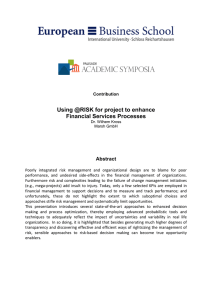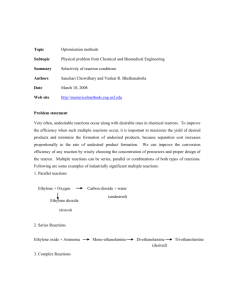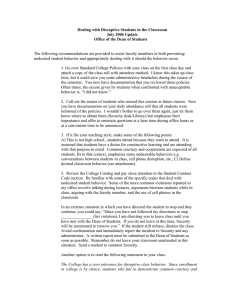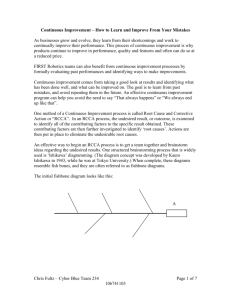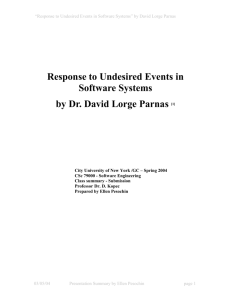Root Cause Analysis - SCI-Pak
advertisement
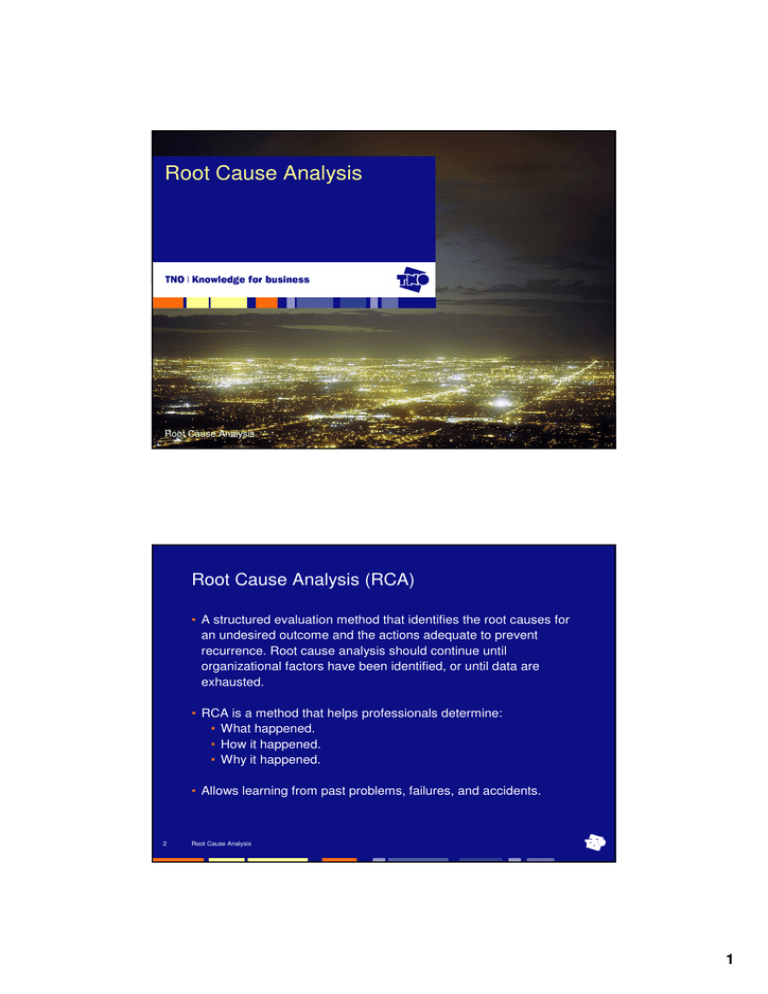
Root Cause Analysis Root Cause Analysis Root Cause Analysis (RCA) • A structured evaluation method that identifies the root causes for an undesired outcome and the actions adequate to prevent recurrence. Root cause analysis should continue until organizational factors have been identified, or until data are exhausted. • RCA is a method that helps professionals determine: • What happened. • How it happened. • Why it happened. • Allows learning from past problems, failures, and accidents. 2 Root Cause Analysis 1 Example • For example: A fuse blows out and cause(s) the lights to go off. You can identify the proximate cause, “fuse blew”, and replace the fuse. You can also identify the intermediate cause “a short” and repair the wire that shorted. However, if you do not identify and correct the organizational factor that led to the fuse going out (e.g., wiring not maintained because there was insufficient maintenance budget), other systems may have similar failures due to lack of maintenance. Root cause analysis seeks to identify the systemic problems, such as lack of maintenance budget, and correct these so that related problems or mishaps do not occur. 3 Root Cause Analysis Overview of Steps in Root Cause Analysis • • • • • • 4 Clearly define the undesired outcome. Gather data, including a list of all potential causes. Create an event and causal factor tree. Continue asking “why” to identify root causes. Check your logic and eliminate items that are not causes. Generate solutions that address both proximate causes and root causes. Root Cause Analysis 2 Root Cause Analysis - Steps Clearly define the undesirable outcome. • Describe the undesired outcome. • For example: “relief valve failed,” “employee broke his arm,” “XYZ project schedule significantly slipped.” 5 Root Cause Analysis Root Cause Analysis - Steps Gather data. • Identify facts surrounding the undesired outcome. • When did the undesired outcome occur? • Where did it occur? • What conditions were present prior to its occurrence? • What controls or barriers could have prevented its occurrence but did not? • What are all the potential causes? • What actions can prevent recurrence? 6 Root Cause Analysis 3 Root Cause Analysis - Steps Create an event and causal factor tree. • Place the undesired outcome at the top of the tree. • Add all events, conditions, and exceeded/failed barriers that occurred immediately before the undesired outcome and might have caused it. 7 Root Cause Analysis Root Cause Analysis - Steps • Brainstorm to ensure that all possible causes are included, NOT just those that you are sure are involved. • Be sure to consider people, hardware, software, policy, procedures, and the environment. 8 Root Cause Analysis 4 Definitions Event • A real-time occurrence describing one discrete action, typically an error, failure, or malfunction. • Examples: pipe broke, power lost, lightning struck, person opened valve, etc… Condition • Any as-found state, whether or not resulting from an event, that may have safety, health, quality, security, operational, or environmental implications. Barrier • A physical device or an administrative control used to reduce risk of the undesired outcome to an acceptable level. • Barriers can provide physical intervention (e.g., a guardrail) or procedural separation in time and space (e.g., lock-out-tag-out procedure). 9 Root Cause Analysis Causal factor tree 10 Root Cause Analysis 5 Root Cause Analysis - Steps • After you have identified all the possible causes, ask yourself “WHY” each may have occurred. • Be sure to keep your questions focused on the original issue. For example: • “Why was the condition present?”; • “Why did the event occur?”; • “Why was the barrier exceeded?” or • “Why did the barrier fail?” 11 Root Cause Analysis Root Cause Analysis - Steps Continue to ask “why” until you have reached: • Root cause(s) - including all organizational factors that exert control over the design, fabrication, development, maintenance, operation, and disposal of the system. • A problem that is not correctable by the company or a contractor. • Insufficient data to continue. 12 Root Cause Analysis 6 Root Cause Analysis - Steps Check your logic with a detailed review of each potential cause. • Compare a cause with facts to verify it is a contributor. • If the action, deficiency, or decision in question were corrected, eliminated or avoided, would the undesired outcome be prevented or avoided? • If yes, then it is a cause. Keep it on the tree. • If no, then eliminate it from the tree. 13 Root Cause Analysis Create an event and causal factor tree continued… • The remaining items on the tree are the causes (or probable causes) necessary to produce the undesired outcome. • Proximate causes are those immediately before the undesired outcome. • Intermediate causes are those between the proximate and root causes. • Root causes are organizational factors or systemic problems located at the bottom of the tree. 14 Root Cause Analysis 7 Recommendations Generating Recommendations: • At a minimum corrective actions should be generated to eliminate proximate causes and eliminate or mitigate the negative effects of root causes. When multiple causes exist, there is limited budget, or it is difficult to determine what should be corrected: • Quantitative analysis can be used to determine the total contribution of each cause to the undesirable outcome. • Fishbone diagrams (or other methods) can be used to arrange causes in order of their importance. • Those causes which contribute most to the undesirable outcome should be eliminated or the negative effects should be mitigated to minimize risk. 15 Root Cause Analysis Definitions • Cause (Causal Factor): An event or condition that results in an effect. Anything that shapes or influences the outcome. • Proximate Cause(s): The event(s) that occurred, including any condition(s) that existed immediately before the undesired outcome, directly resulted in its occurrence and, if eliminated or modified, would have prevented the undesired outcome. Also known as the direct cause(s). • Root Cause(s): One of multiple factors (events, conditions or organizational factors) that contributed to or created the proximate cause and subsequent undesired outcome and, if eliminated, or modified would have prevented the undesired outcome. Typically multiple root causes contribute to an undesired outcome. 16 Root Cause Analysis 8 Definitions • Root Cause Analysis (RCA): A structured evaluation method that identifies the root causes for an undesired outcome and the actions adequate to prevent recurrence. Root cause analysis should continue until organizational factors have been identified, or until data are exhausted. • Event: A real-time occurrence describing one discrete action, typically an error, failure, or malfunction. Examples: pipe broke, power lost, lightning struck, person opened valve, etc… • Condition: Any as-found state, whether or not resulting from an event, that may have safety, health, quality, security, operational, or environmental implications. 17 Root Cause Analysis Definitions • Organizational Factors: Any operational or management structural entity that exerts control over the system at any stage in its life cycle, including but not limited to the system’s concept development, design, fabrication, test, maintenance, operation, and disposal. Examples: resource management (budget, staff, training); policy (content, implementation, verification); and management decisions. • Contributing Factor: An event or condition that may have contributed to the occurrence of an undesired outcome but, if eliminated or modified, would not by itself have prevented the occurrence. 18 Root Cause Analysis 9 Definitions • Barrier: A physical device or an administrative control used to reduce risk of the undesired outcome to an acceptable level. Barriers can provide physical intervention (e.g., a guardrail) or procedural separation in time and space (e.g., lock-out-tag-out procedure). 19 Root Cause Analysis Fishbone diagram 20 Root Cause Analysis 10 Fishbone diagram 21 Root Cause Analysis Fishbone diagram 22 Root Cause Analysis 11
